The way consumers and businesses think about security and public safety has changed drastically since the start of the coronavirus pandemic. While the public was generally aware of their sense of security, personal safety and well-being pre-pandemic, there’s no escaping urgent reminders today to remain six feet apart from others while in public, wear face coverings, wash hands frequently and get temperature checks and COVID tests as needed or required.
As the country works on safely re-opening businesses, schools, offices, airports and other public spaces, much of the future remains uncertain in terms of the systems and processes for how this can be done effectively and safely. Security and public safety technology and professionals play an important role in enabling the safe reopening and recovery of America. By deploying technologies like smart video, mobile, biometrics and more, businesses and other public spaces will be able to increasingly reopen with confidence and with the ability to consistently monitor and assess progress.
Utilizing Technology to Enhance Public Safety
In order for the country to safely return to a new normalcy in the midst of COVID-19, widespread adoption of innovative technologies will be critical. From connected devices, thermal/video technology, mobile solutions and biometrics, technology is further revolutionizing the way we think about innovations for public safety, security and health.
IoT device technologies and connected devices are already being adopted to help reduce the spread of the disease as public spaces begin reopening. For example, we’re seeing this with schools and universities around the country as they create their own apps for students and faculty to use for coronavirus status updates, access IDs for entry and more. As students and faculty are frequently tested at schools that have reopened for in-person instruction, administrators can keep track of people who are ill, communicate with them and limit access to certain buildings with a unique QR code for identification and entry access.
While many institutions are starting to benefit from this technology, businesses and other office settings can also implement mobile apps for contact tracing within their organization to easily alert people if they’ve been exposed, and immediately limit entry to certain facilities if a person has tested positive. Widespread deployment, quality systems and processes will be essential, and need to be well coordinated across the state and federal level.
Additionally, smart video technology, like thermal imaging, is being used for efficient temperature testing in public facilities like casinos, and for automating crowd density monitoring in facilities such as large retail locations. Finally, touchless biometric, like retina scanning and facial recognition, and mobile-based access control solutions will be essential tools for getting business and public spaces effectively opened again.
Security’s Role in Creating a Safe Future
Security plays a central role in keeping people safe – and now even more so as we deal with the impact of COVID-19 on businesses and public spaces. The role of security professionals now is becoming one of both security and health monitoring and as we get to 2021 and beyond, integrated security/health products will become increasingly common and available.
While technology should be a fundamental part of any security plan, providing education and training resources to employees and the general public is also necessary in creating a holistic approach that keeps both employees and citizens safe. Even if an organization doesn’t have a dedicated in-house security team or expert, all employees can and should feel empowered to uphold protocols set in place and have the information necessary to know how to use and control their organization’s security technology. This can be achieved through in-person or online trainings and educational resources through organizations like the Security Industry Association, virtual events like ISC West, and more.
Ensuring the safety, well-being and comfort of customers, employees and the general public will be critical factors in getting the economy back to its activity level pre-pandemic. We’ve already seen many use cases of security and public safety innovations being put to the test around the globe, and as best practices are established, these are only going to grow as we continue living with the long-term effects of the pandemic. Coordination across public safety, health and security professionals are essential to this success and the industry will play a key leadership role for a safe future.


